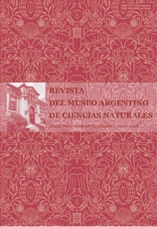Análisis faunístico de vertebrados de las toscas del Río de La Plata (Buenos Aires, Argentina): un yacimiento paleontológico en desaparición
Resumen
Faunistic analisys of vertebrates from las toscas del Río de La Plata (Buenos Aires,
Argentina): a palaeontological site in disappearance. At the coast of the río de la Plata in the Buenos
Aires city lies a classic paleontological site, known as toscas del Río de La Plata or simple as las toscas. It has
been studied for over 120 years and, although it has been widely spread, today is only possible to observe it
during low tide. For this reason, most of the available materials are those collected during the first half of the
XXth century, and that so far have only been incorporated into scarce taxonomic reviews. Among the fossils
collected in las toscas highlights Glyptodon munizi Ameghino, Neosclerocalyptus pseudornatus Ameghino,
Mesotherium cristatum Serrés, Arctotherium angustidens Gervais y Ameghino and Theriodictis platensis
(Mercerat); all are exclusive species from the Ensenadan Stage (early to -middle Pleistocene). The sediments of
las toscas were deposited during times of normal polarity, more precisely during the Jaramillo event (Chron
C1r1n, ca. de 1 Ma). Faunistic evidences (e.g. Tolypeutes, Catagonus) allow to interpret las toscas as an open
environment with dry conditions and probably colder than the present.
Argentina): a palaeontological site in disappearance. At the coast of the río de la Plata in the Buenos
Aires city lies a classic paleontological site, known as toscas del Río de La Plata or simple as las toscas. It has
been studied for over 120 years and, although it has been widely spread, today is only possible to observe it
during low tide. For this reason, most of the available materials are those collected during the first half of the
XXth century, and that so far have only been incorporated into scarce taxonomic reviews. Among the fossils
collected in las toscas highlights Glyptodon munizi Ameghino, Neosclerocalyptus pseudornatus Ameghino,
Mesotherium cristatum Serrés, Arctotherium angustidens Gervais y Ameghino and Theriodictis platensis
(Mercerat); all are exclusive species from the Ensenadan Stage (early to -middle Pleistocene). The sediments of
las toscas were deposited during times of normal polarity, more precisely during the Jaramillo event (Chron
C1r1n, ca. de 1 Ma). Faunistic evidences (e.g. Tolypeutes, Catagonus) allow to interpret las toscas as an open
environment with dry conditions and probably colder than the present.
Texto completo:
PDFEnlaces refback
- No hay ningún enlace refback.

This work is licensed under a Creative Commons Attribution 3.0 License.

